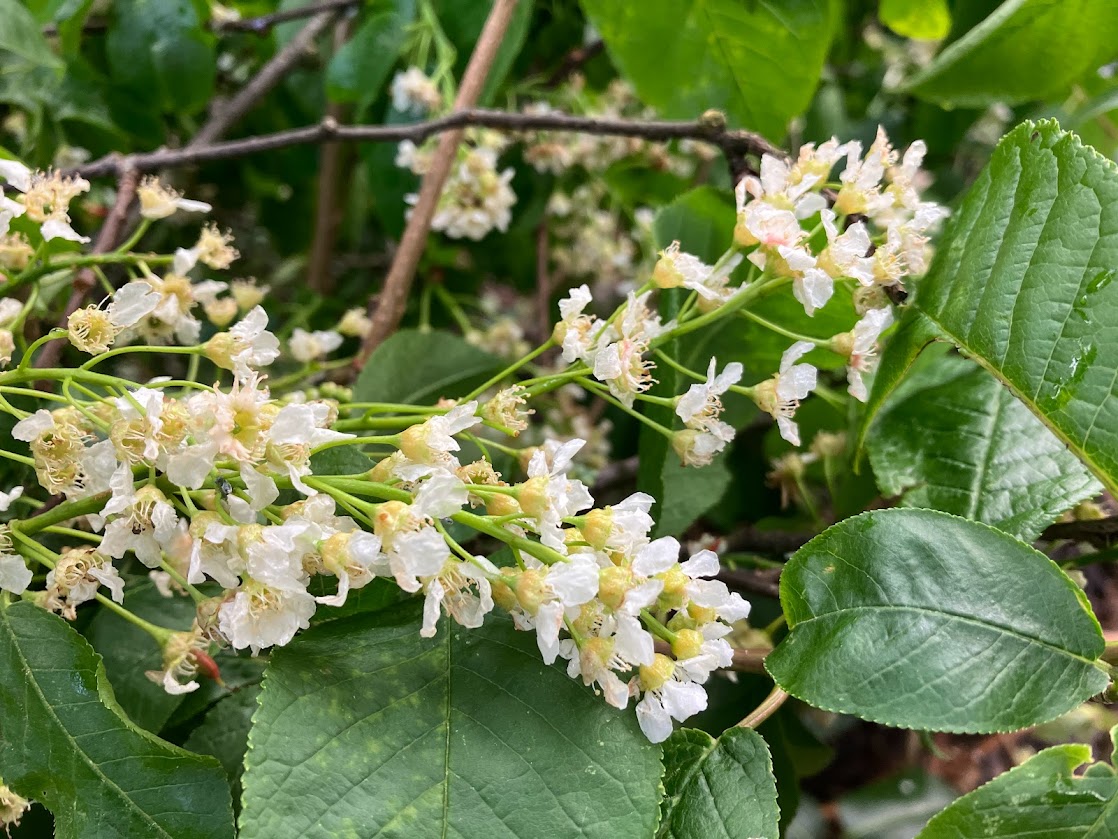Days of Sun and Rain
19 April 2023

In the grey light of evening the garden looks wrong: a branch has fallen across the path, causing a frothing white sea of blossom at ground level instead of high in the canopy.
Picking my way down the steps I recognise the familiar silence that falls whenever something unusual happens here. It is reminiscent of the pale spring morning I found a bluetit drowned in the pond. The hot afternoon when the remains of a squirrel – furred head and tail intact but sinew and bone between – had been strung across the hazel. And that other day, two years before, when the wild cherry creaked and groaned, and the first limb snapped.
That was in May, when strong winds had got the better of the whippy stems heavy with leaves and embryonic fruits. That bough fell across the pond and revealed in the trunk the concentric waves of a dense, blackening rot. In previous years, the branch had held a rope ladder, and then a swing. It had strained against our children’s weight, their arboreal exploration and occasional experimental axing. It was my daughter’s tree, chosen as a concession to the birds we wanted to attract and, I thought, as Prunus avium is a native, it would be strong enough to last.
Now, after a series of gusts at 46mph, a third of the tree is down, covering an area of at least 20 by 30 feet. There is a smell, faint but cloying, already catching slightly at the back of the throat. It’s the amygdalin, a cyanogenic glycoside, released when leaves become stressed or wilted - a chemical that converts to hydrogen cyanide when ingested, killer of cats, dogs, horses, us. We view the situation with dismay: sadness that it is another part of childhood gone, but also the dread of having to chop, clear and chip into a mulch that will be too toxic to use for weeks.
That first evening, we stand in light drizzle and make two piles. The next day we wake up early and start sawing logs. Rain at half nine keeps us out of the garden until five and then the chipping starts. With every passing hour decay progresses as the tree breaks down, releasing more gas. By the following morning, in the warming sunshine, we are sickened by the sour aroma, imagining a miasma exuding from the broken stems, phantom fingers plucking at the cells inside our noses, finding ways to be absorbed. We finish the job at ten, filthy and soulless, sunken in a dull mood that lingers all day. It is not until two days later that the world seems suddenly sharp and bright, and I realize what a rank, nauseating spell we have been under.
The birds recovered faster. The wren began flitting across the remaining branches within hours of the fall. The magpies returned the next day to their fortress of a nest - some two feet wide and three feet long, built with a ‘not on my watch’ attitude by the father who fell out of his own nest last summer. The blackbird, I am sure, never really left.
And the tree? It is righting itself, with every sunny day, auxins rush to the opposite side to the sun, capitalising on the sudden, new exposure to light. Reddish, welted bark is patched with greying lenticels, as it should be. New leaves, toothed and oval, are a young fresh green swelling with chloroplasts, as they should be. Clusters of tiny flowers stretch out their stamens, as they should be. And yet the rot on the trunk glares out at us, a death mask made before decease, and we contemplate strategies for bringing the remaining branches down.
On a walk back from the river, we look out for other lost limbs, and previous attempts at tree-repair. We discover that some do well when reduced to stumps, allowing a whole new ring of stems each contending for the apical role. We consider different strategies and potential outcomes. We worry that it will come down of its own accord in another high wind, but we conclude that if we are to intervene, we must wait until autumn. For the nesting birds. For all the animals that rely on its fruit. For our own sanity and to spare us the rank, caustic scent.
Strangely, wild cherry makes some of the most sought-after firewood, burning long and bright through winter nights and exuding a sweet, pleasant aroma alike to its flowers, they say. Unlike elder wood, which releases cyanide gas as it burns, as thousands of medieval peasants found out on their way to the grave.
I ask my daughter what she’d like as a replacement for her 40-foot giant in case our plans for restoration go wrong. Something small, she says. Something pink. Something that smells good. Whatever we pick I know already it will have years of competition. This tree isn’t going down without a fight, it has been sending out suckers for years, crafting its legacy and making its own woodland. Each new daughter taking on the role of the mother-tree, determined to survive.
Glossary
Apical: the apical stem is the main stem
Auxin: a plant growth hormone
Lenticel: pores in the stem that allow gas exchange
